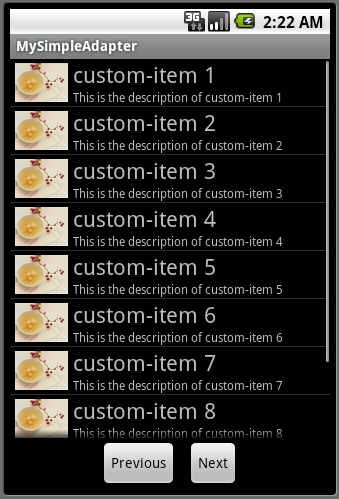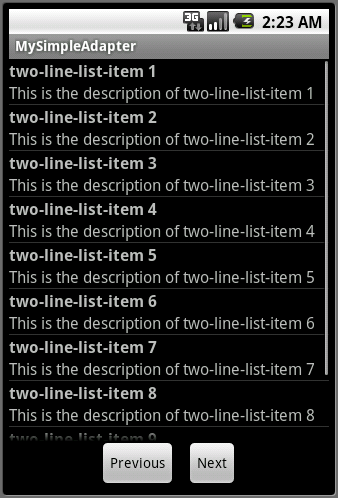在使用ListView的时候,经常看到需要为List中的item添加诸如“android.R.layout.simple_list_item_2”、“android.R.layout.two_line_list_item”之类的布局。用起来虽然简单,但却不明其所以然。下面来探究一下、学习一下它的源码和应用一下:
例子代码://main.xml
- <?xml version="1.0" encoding="utf-8"?>
- <LinearLayout xmlns:android="http://schemas.android.com/apk/res/android"
- android:layout_width="fill_parent"
- android:layout_height="wrap_content"
- android:orientation="vertical"
- >
- <ListView android:id="@+id/android:list"
- android:layout_width="fill_parent"
- android:layout_height="fill_parent"
- android:layout_weight="1"
- android:drawSelectorOnTop="false"
- />
- <LinearLayout
- android:layout_width="fill_parent"
- android:layout_height="wrap_content"
- android:orientation="horizontal"
- android:gravity="center_horizontal"
- >
- <Button android:id="@+id/btnPrevious"
- android:layout_width="wrap_content"
- android:layout_height="wrap_content"
- android:layout_marginRight="10dip"
- android:text="Previous">
- </Button>
- <Button android:id="@+id/btnNext"
- android:layout_width="wrap_content"
- android:layout_height="wrap_content"
- android:text="Next">
- </Button>
- </LinearLayout>
- </LinearLayout>
//list_item.xml
- <?xml version="1.0" encoding="utf-8"?>
- <RelativeLayout xmlns:android="http://schemas.android.com/apk/res/android"
- android:layout_width="fill_parent"
- android:layout_height="wrap_content">
- <ImageView android:id="@+id/imageView"
- android:layout_width="wrap_content"
- android:layout_height="wrap_content"
- android:layout_centerVertical="true"
- android:layout_marginLeft="5px"
- android:layout_marginRight="5px"
- android:src="@drawable/tea_80x59"
- />
- <TextView android:id="@+id/titleTextView"
- android:layout_width="fill_parent"
- android:layout_height="wrap_content"
- android:layout_toRightOf="@id/imageView"
- android:textSize="22px"
- />
- <TextView android:id="@+id/descTextView"
- android:layout_width="fill_parent"
- android:layout_height="wrap_content"
- android:layout_toRightOf="@id/imageView"
- android:layout_below="@id/titleTextView"
- android:textSize="12px"
- />
- </RelativeLayout>
//MySimpleAdapterActivity.java
- package com.tutor.simpleadapter;
- import java.util.ArrayList;
- import java.util.HashMap;
- import java.util.List;
- import java.util.Map;
- import android.app.Activity;
- import android.app.ListActivity;
- import android.content.Intent;
- import android.os.Bundle;
- import android.util.Log;
- import android.view.View;
- import android.widget.Button;
- import android.widget.ListView;
- import android.widget.SimpleAdapter;
- import android.widget.Toast;
- public class MySimpleAdapterActivity extends ListActivity {
- private Button btnPrevious = null;
- private Button btnNext = null;
- private String TAG = "SimpleAdapter";
- private int index = 0;
- /** Called when the activity is first created. */
- @Override
- public void onCreate(Bundle savedInstanceState) {
- super.onCreate(savedInstanceState);
- setContentView(R.layout.main);
- btnPrevious = (Button)findViewById(R.id.btnPrevious);
- btnNext = (Button)findViewById(R.id.btnNext);
- btnPrevious.setOnClickListener(new ButtonClickListener(this));
- btnNext.setOnClickListener(new ButtonClickListener(this));
- Intent intent = getIntent();
- index = intent.getIntExtra("Index", 0);
- Log.d(TAG, "onCreate "+index);
- switch((index % 3)) {
- case 0://自定义的List Item布局
- setListAdapter(new SimpleAdapter(this,
- getData("custom-item"),
- R.layout.list_item,
- new String[]{"title", "description"},
- new int[]{R.id.titleTextView, R.id.descTextView}));
- Log.i(TAG, "SimpleAdapter with R.layout.list_1");
- break;
- case 1://Android提供的simple_list_item_2布局
- setListAdapter(new SimpleAdapter(this,
- getData("simple-list-item-2"),
- android.R.layout.simple_list_item_2,
- new String[]{"title", "description"},
- new int[]{android.R.id.text1, android.R.id.text2}));
- Log.i(TAG, "SimpleAdapter with android.R.layout.simple_list_item_2");
- break;
- case 2://Android提供的two_line_list_item布局
- setListAdapter(new SimpleAdapter(this,
- getData("two-line-list-item"),
- android.R.layout.two_line_list_item,
- new String[]{"title", "description"},
- new int[]{android.R.id.text1, android.R.id.text2}));
- Log.i(TAG, "SimpleAdapter with android.R.layout.two_line_list_item");
- break;
- default:
- Log.i(TAG, "no SimpleAdapter");
- }
- }
- protected void onRestart() {
- super.onRestart();
- Log.d(TAG, "onRestart "+index);
- }
- protected void onStart() {
- super.onStart();
- Log.d(TAG, "");
- }
- protected void onResume() {
- super.onResume();
- Log.d(TAG, "onResume "+index);
- }
- protected void onPause() {
- super.onPause();
- Log.d(TAG, "onPause "+index);
- }
- protected void onStop () {
- super.onStop();
- Log.d(TAG, "onStop "+index);
- }
- protected void onDestroy() {
- Log.d(TAG, "onDestroy "+index);
- if(btnPrevious != null) {
- btnPrevious.setOnClickListener(null);
- btnPrevious = null;
- }
- if(btnNext != null) {
- btnNext.setOnClickListener(null);
- btnNext = null;
- }
- super.onDestroy();
- }
- /**
- * 构造SimpleAdapter的第二个参数,类型为List<Map<?,?>>
- * @param title
- * @return
- */
- private List<Map<String, String>> getData(String title) {
- List<Map<String, String>> listData = new ArrayList<Map<String, String>>();
- for(int i = 1; i<=10; i++) {
- Map<String, String> map = new HashMap<String, String>();
- map.put("title", title+" "+i);
- map.put("description", "This is the description of "+title+" "+i);
- listData.add(map);
- }
- return listData;
- }
- /**
- * 当List的项被选中时触发
- */
- protected void onListItemClick(ListView listView, View v, int position, long id) {
- Map map = (Map)listView.getItemAtPosition(position);
- Toast toast = Toast.makeText(this, map.get("title")+" is selected.", Toast.LENGTH_LONG);
- toast.show();
- }
- class ButtonClickListener implements View.OnClickListener {
- private Activity context = null;
- public ButtonClickListener(Activity context) {
- this.context = context;
- }
- @Override
- public void onClick(View v) {
- // TODO Auto-generated method stub
- if(context != null) {
- Intent intent = context.getIntent();
- int index = intent.getIntExtra("Index", 0);
- if(v.getId() == R.id.btnNext) {
- index += 1;
- }else if(v.getId() == R.id.btnPrevious) {
- index -= 1;
- if(index < 0) {
- index = Math.abs(index);
- }
- }
- //发起新的Activity
- Intent newIntent = new Intent(context, MySimpleAdapterActivity.class);
- newIntent.putExtra("Index", index);
- context.startActivity(newIntent);
- //关闭原来的Activity
- context.finish();
- }
- }
- }
- }
//下面两个是Android自带的布局,直接引用即可,不用添加到工程中:
//base/core/res/res/layout/simple_list_item_2.xml
- <TwoLineListItem xmlns:android="http://schemas.android.com/apk/res/android"
- android:paddingTop="2dip"
- android:paddingBottom="2dip"
- android:layout_width="match_parent"
- android:layout_height="wrap_content"
- android:minHeight="?android:attr/listPreferredItemHeight"
- android:mode="twoLine"
- >
- <TextView android:id="@android:id/text1"
- android:layout_width="match_parent"
- android:layout_height="wrap_content"
- android:layout_marginLeft="6dip"
- android:layout_marginTop="6dip"
- android:textAppearance="?android:attr/textAppearanceLarge"
- />
- <TextView android:id="@android:id/text2"
- android:layout_width="match_parent"
- android:layout_height="wrap_content"
- android:layout_below="@android:id/text1"
- android:layout_alignLeft="@android:id/text1"
- android:textAppearance="?android:attr/textAppearanceSmall"
- />
- </TwoLineListItem>
//base/core/res/res/layout/two_line_list_item.xml
- <LinearLayout xmlns:android="http://schemas.android.com/apk/res/android"
- android:layout_width="match_parent"
- android:layout_height="wrap_content"
- android:orientation="vertical">
- <TextView android:id="@android:id/text1"
- android:textSize="16sp"
- android:textStyle="bold"
- android:layout_width="match_parent"
- android:layout_height="wrap_content"/>
- <TextView android:id="@android:id/text2"
- android:textSize="16sp"
- android:layout_width="match_parent"
- android:layout_height="wrap_content"/>
- </LinearLayout>
运行的结果如下:



例子中,List中的item布局有三种:
- 自定义的布局,使用了相对布局(RelativeLayout,见list_item.xml),左侧一个图片,右侧上方是字体比较大的title,下方是字体稍小的description;
- 第二种是Android自带的布局(见源码里的simple_list_item_2.xml),主要是一个垂直的LinearLayout,里面包含两个ID分别为text1、text2的TextView,这两个TextView的字体大小不一样,一个带textAppearanceLarge属性,另外一个带textAppearanceSmall属性;
- 第三种也是Android自带的布局(见源码里的two_line_list_item.xml),主要是一个垂直的LinearLayout,里面包含两个ID分别为text1、text2的TextView,这两个TextView的字体大小一样,但每个TextView还带一个字体加粗的属性。
SimpleAdapter的使用:
构造函数: SimpleAdapter(Context context, List<? extends Map<String, ?>> data, int resource, String[] from, int[] to)
参数有5个:
- context:也就是上下文,而Activity都是继承于Context的,所以这个参数一般使用Activity的实例;
- data:类型要为一个List的子类,且List中的每个元素都必须为Map的子类,每个Map中以有一对或多对的Key-Value对,这些值与下面的参数from有对应;
- resource:这是每个List项(Item)对应的XML布局资源文件名,在里面控制List项显示的元素以及相对位置;
- from:是一个字符串数组,可以理解为列名,对应于data数据中Map元素的Key值,只有包含在这个字符串数组的元素对应到Map中的Value值才能显示到TextView中(这些TextView在最后一个参数to配置),所以这些Value值需要为字符串或者有toString()的方法;
- to:TextView组件ID的数组,上面的from参数配置了Key值,而根据这个Key值从data参数里的map取出的value值需要设置到TextView中,而这些TextView的id需要在这个数组中配置。而且这些TextView需要在参数resource对应的XML资源文件中配置。
补充:
例子中使用了ListActivity,它有默认的XML资源文件;但由于本例需要添加两个按钮(原来的布局是没有按钮),所以重新在main.xml中配置了一个ListView,且ListActivity要求放到它里面的ListView的ID必须是 android:list 。本例的两个按钮主要是切换不同的ListActivity来显示ListView项的三种不同布局,一种是自定义的,另外两种是Android自带的常用ListView项布局。





















 1075
1075

 被折叠的 条评论
为什么被折叠?
被折叠的 条评论
为什么被折叠?








